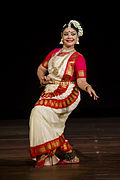| Revision as of 05:27, 2 June 2022 editAkalanka820 (talk | contribs)Extended confirmed users, Pending changes reviewers, Rollbackers4,010 edits →One general info needed: new sectionTags: Mobile edit Mobile web edit← Previous edit | Revision as of 07:41, 2 June 2022 edit undoAkalanka820 (talk | contribs)Extended confirmed users, Pending changes reviewers, Rollbackers4,010 edits →One general info needed: minor correctionsNext edit → | ||
| Line 239: | Line 239: | ||
| == One general info needed == | == One general info needed == | ||
| Dear FF Sir, I had added this on an ] page: " Ahirs who were mainly classed as having lowly status in the social hierarchy took to ] an attempt by low castes to rise up the social ladder, often by tracing their origins to mythical warrior characters or following the lifestyle of higher ''varna''.<ref>{{Cite book |last1=Berti |first1=Daniela |title=''Cultural Entrenchment of Hindutva'' Local Mediations and Forms of Convergence |last2=Kanungo |first2=Pralay |last3=Jaoul |first3=Nicolas |publisher=] |year=2011 |isbn=978-1-138-65995-7 |edition=1st |pages=246 |language=English |quote=Marginalised groups, often considered as Shudras, like the Ahirs (Yadavs), Kurmis and the Gujars, began to redefine their emerging political and economic role in society by fighting on the same ‘religious’ grounds. In so doing, they refashioned their status as warriors and kings who had played a special role in history as guardians of Hinduism (Gooptu 2001 : 195; see also Pinch 1996 : 118–38). Gyanendra Pandey (1990: 66–108) describes how, since the end of the 19th century, such processes of Sanskritisation (adoption of ‘higher’ forms of Hinduism) among lower castes have joined up with Hindu nationalist movements, such as the cow protection movement, and how these interrelations have been central to the formation of a Hindu and a Muslim community in northern India.}}</ref>" but after your recent changes on ] page, I am bit confused as to whether I should modify the lines and add your reference there to |
Dear FF Sir, I had added this on an ] page: " Ahirs who were mainly classed as having lowly status in the social hierarchy took to ] an attempt by low castes to rise up the social ladder, often by tracing their origins to mythical warrior characters or following the lifestyle of higher ''varna''.<ref>{{Cite book |last1=Berti |first1=Daniela |title=''Cultural Entrenchment of Hindutva'' Local Mediations and Forms of Convergence |last2=Kanungo |first2=Pralay |last3=Jaoul |first3=Nicolas |publisher=] |year=2011 |isbn=978-1-138-65995-7 |edition=1st |pages=246 |language=English |quote=Marginalised groups, often considered as Shudras, like the Ahirs (Yadavs), Kurmis and the Gujars, began to redefine their emerging political and economic role in society by fighting on the same ‘religious’ grounds. In so doing, they refashioned their status as warriors and kings who had played a special role in history as guardians of Hinduism (Gooptu 2001 : 195; see also Pinch 1996 : 118–38). Gyanendra Pandey (1990: 66–108) describes how, since the end of the 19th century, such processes of Sanskritisation (adoption of ‘higher’ forms of Hinduism) among lower castes have joined up with Hindu nationalist movements, such as the cow protection movement, and how these interrelations have been central to the formation of a Hindu and a Muslim community in northern India.}}</ref>" but after your recent changes on ] page, I am bit confused as to whether I should modify the lines on ] page and add your reference there to make it ambiguous or leave it as such as other references are very explicit in their description about non-elite status ( indirectly shudra) for this group. Sir, I request for your small response to it below here for the next step. I will go accordingly to it. Thanks RS6784/] (]) 05:27, 2 June 2022 (UTC) | ||
Revision as of 07:41, 2 June 2022
| I am trying to take a little time off from Misplaced Pages to do some unrelated writing. I am around, but my commitments are restricted. Fowler&fowler«Talk» 12:07, 7 February 2021 (UTC) |
This user is aware of the designation of the following topics as contentious topics:
|
|
Archives |
|
1, 2, 3, 4, 5, 6, 7, 8, 9, 10 |
|
This page has archives. Sections older than 10 days may be automatically archived by Lowercase sigmabot III. |
Archive 22 Archive 23 Archive 24 Archive 25 Archive 26
Krishna Dev
Fowler&fowler: You have added about Krishna Dev, whose article is included in the Mahabodhi Centenary volume, 1891-1991: "Krishna Dev, formerly and latterly, David Berry Knapp, the mayor of Rajneeshpuram"
I was wondering how you equated the two? Malaiya (talk) 07:21, 27 May 2022 (UTC)
India-related FPs I
-
 Indian vultures, (Gyps indicus), in a nest on the tower of the Chaturbhuj Temple, Orchha, Madhya Pradesh. The vulture became nearly extinct in India in the 1990s from having ingested the carrion of diclofenac-laced cattle.
Indian vultures, (Gyps indicus), in a nest on the tower of the Chaturbhuj Temple, Orchha, Madhya Pradesh. The vulture became nearly extinct in India in the 1990s from having ingested the carrion of diclofenac-laced cattle. 
-
 The bank myna is indigenous to the Indian subcontinent.
The bank myna is indigenous to the Indian subcontinent. 
-
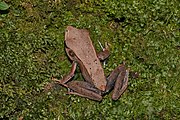 The vulnerable Malabar frog is endemic to the Western Ghats.
The vulnerable Malabar frog is endemic to the Western Ghats.
-
 The endangered Nilgiri tahr is endemic to the Western Ghats. Shown here is a female in a national park in Kerala.
The endangered Nilgiri tahr is endemic to the Western Ghats. Shown here is a female in a national park in Kerala. 
India-related FPs II
-
 The brahminy kite (Haliastur indus) hunts for fish and other prey near the coasts and around inland wetlands.
The brahminy kite (Haliastur indus) hunts for fish and other prey near the coasts and around inland wetlands. 
-
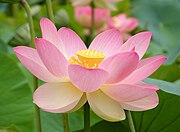 The lotus (Nelumbo nucifera) is the Indian national flower. Hindus and Buddhists regard it as a sacred symbol of enlightenment.
The lotus (Nelumbo nucifera) is the Indian national flower. Hindus and Buddhists regard it as a sacred symbol of enlightenment. 
-
 The Indian peafowl (Pavo cristatus) is the Indian national bird. It roosts in moist and dry-deciduous forests, cultivated areas, and village precincts.
The Indian peafowl (Pavo cristatus) is the Indian national bird. It roosts in moist and dry-deciduous forests, cultivated areas, and village precincts. 
-
 The Pahalgam valley in Jammu and Kashmir is covered with a temperate coniferous forest.
The Pahalgam valley in Jammu and Kashmir is covered with a temperate coniferous forest. 
India-related FPs III
-
A Toda tribal hut exemplifies Indian vernacular architecture.

-
 Bangles on display in Bangalore India
Bangles on display in Bangalore India 
-
 A Sadhu and a picture of Siva in Kayasth Tola, Varanasi, Uttar Pradesh in Northern India
A Sadhu and a picture of Siva in Kayasth Tola, Varanasi, Uttar Pradesh in Northern India 
-
 The pushkarani, or tank, located on the eastern side of Krishna temple in Hampi, Karnataka, the seat of the Vijayanagara Empire
The pushkarani, or tank, located on the eastern side of Krishna temple in Hampi, Karnataka, the seat of the Vijayanagara Empire 
India-related FPs IV
-
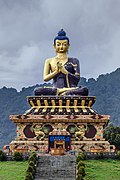 Large Gautama Buddha statue in Buddha Park of Ravangla, Sikkim
Large Gautama Buddha statue in Buddha Park of Ravangla, Sikkim 
-
 A Jain woman washes the feet of Bahubali Gomateswara at Shravanabelagola, Karnataka. The Bahubali idol is 18 metres (58 ft) high and is carved out of a single rock on top of a hill.
A Jain woman washes the feet of Bahubali Gomateswara at Shravanabelagola, Karnataka. The Bahubali idol is 18 metres (58 ft) high and is carved out of a single rock on top of a hill. 
-
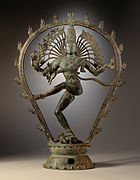 A Chola bronze depicting Nataraja, who is seen as a cosmic "Lord of the Dance" and representative of Shiva
A Chola bronze depicting Nataraja, who is seen as a cosmic "Lord of the Dance" and representative of Shiva 
-
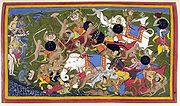 A sixteenth century rendering of a scene from the Ramayana, an ancient Sanskrit epic.
A sixteenth century rendering of a scene from the Ramayana, an ancient Sanskrit epic. 
India-related FPs V
-
 Paintings at the Ajanta Caves in Aurangabad, Maharashtra, 6th century
Paintings at the Ajanta Caves in Aurangabad, Maharashtra, 6th century 
-
 The Agasthiyamalai range, constituting the southern end of the Western Ghats, as seen from the rainshadow region of the southwest monsoon in Tirunelveli, Tamil Nadu.
The Agasthiyamalai range, constituting the southern end of the Western Ghats, as seen from the rainshadow region of the southwest monsoon in Tirunelveli, Tamil Nadu. 
-
 A beach off the Arabian Sea in Puvar, Kerala. The Arabian Sea is the northwestern region of the Indian Ocean, bounded by the Arabian and Indian peninsulas.
A beach off the Arabian Sea in Puvar, Kerala. The Arabian Sea is the northwestern region of the Indian Ocean, bounded by the Arabian and Indian peninsulas. 
-
Flowing through its rocky terrain near Hampi is the Tungabhadra river, the major right bank tributary of the Krishna river, a peninsular river, which empties into the Bay of Bengal. The coracles, made of wicker, are traditionally covered with hide, their circular shape preventing them from overturning in rivers with rocky outcrops.

India-related FPs VI
-
 The recycling industry in India, a Varanasi paper bag seller
The recycling industry in India, a Varanasi paper bag seller 
-
 An example of the Chinese fishing nets of Cochin. Fisheries in India is a major industry in its coastal states, employing over 14 million people. The annual catch doubled between 1990 and 2010.
An example of the Chinese fishing nets of Cochin. Fisheries in India is a major industry in its coastal states, employing over 14 million people. The annual catch doubled between 1990 and 2010. 
-
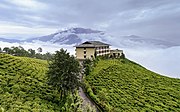 A tea garden in Sikkim. India, the world's second largest-producer of tea, is a nation of one billion tea drinkers, who consume 70% of India's tea output.
A tea garden in Sikkim. India, the world's second largest-producer of tea, is a nation of one billion tea drinkers, who consume 70% of India's tea output. 
-
A daily wage worker in a salt field. The average minimum wage of daily labourers is around Rs.100 per day

India-related FPs VII
-
 A bharatnatyam concert in 2014
A bharatnatyam concert in 2014 
-
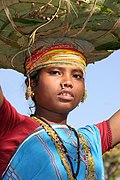 A Bondo woman walks to a weekly market in Chhattisgarh.
A Bondo woman walks to a weekly market in Chhattisgarh. 
-
A woman in Bundi, Rajasthan

-
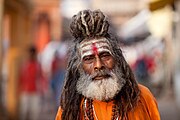 An ascetic in Varanasi, Uttar Pradesh
An ascetic in Varanasi, Uttar Pradesh 
India-related FPs VIII
-
 The tomb of Itmad Ud Daulah, Agra,
The tomb of Itmad Ud Daulah, Agra, 
-
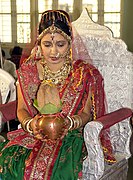 A Hindu bride
A Hindu bride 
-
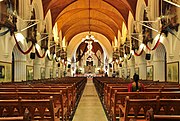 The interior of San Thome Basilica, Chennai, Tamil Nadu. Christianity is believed to have been introduced to India by the late 2nd century by Syriac-speaking Christians.
The interior of San Thome Basilica, Chennai, Tamil Nadu. Christianity is believed to have been introduced to India by the late 2nd century by Syriac-speaking Christians. 
-
 A Sikh pilgrim at the Harmandir Sahib, or Golden Temple, in Amritsar, Punjab
A Sikh pilgrim at the Harmandir Sahib, or Golden Temple, in Amritsar, Punjab 
India-related Classic Pictures-I
-
 A farmer in Rajasthan milks his cow. Milk is India's largest crop by economic value. Worldwide, as of 2011, India had the largest herds of buffalo and cattle, and was the largest producer of milk.
A farmer in Rajasthan milks his cow. Milk is India's largest crop by economic value. Worldwide, as of 2011, India had the largest herds of buffalo and cattle, and was the largest producer of milk.
-
 Indian agriculture dates from the period 7,000–6,000 BCE, employs two thirds of the national workforce, and is second in farm output worldwide. Above, a farmer works an ox-drawn plow in Kadmati, West Bengal.
Indian agriculture dates from the period 7,000–6,000 BCE, employs two thirds of the national workforce, and is second in farm output worldwide. Above, a farmer works an ox-drawn plow in Kadmati, West Bengal.
-
 Schoolchildren in Chambal, Madhya Pradesh eating a mid-day meal. The Mid-Day Meal Scheme attempts to lower rates of childhood malnutrition in India.
Schoolchildren in Chambal, Madhya Pradesh eating a mid-day meal. The Mid-Day Meal Scheme attempts to lower rates of childhood malnutrition in India.
-
 Cricket is the most popular game among India's masses. Shown here is an instance of street cricket.
Cricket is the most popular game among India's masses. Shown here is an instance of street cricket.
India-related FPs IX
-
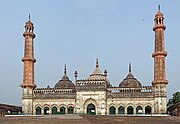 Asfi Masjid at the Bara Imambara complex, Lukcnow, India
Asfi Masjid at the Bara Imambara complex, Lukcnow, India 
-
 Chhota Imambara, Lucknow, India
Chhota Imambara, Lucknow, India 
-
 Taj Mahal mosque, Agra, India
Taj Mahal mosque, Agra, India 
-
 Bangalore panorama
Bangalore panorama 
India-related FPs X
-
 Red Weaver ant, Oecophylla smaragdina in Bangalore, India
Red Weaver ant, Oecophylla smaragdina in Bangalore, India 
-
 Female Telamonia dimidiata in the Lalbagh Botanical gardens, Bangalore, India
Female Telamonia dimidiata in the Lalbagh Botanical gardens, Bangalore, India 
-
 Mysore Palace in the morning
Mysore Palace in the morning 
-
 Indian Olympic athlete, Irfan Kolothum Thodi
Indian Olympic athlete, Irfan Kolothum Thodi 
India-related FPs XI
-
 Grammodes geometrica, Bangalore, India
Grammodes geometrica, Bangalore, India 
-
 Mumtaz Ahmed Khan founder of Al-Ameen Educational Society
Mumtaz Ahmed Khan founder of Al-Ameen Educational Society 
-
 Al-Ameen College of Pharmacy, Bangalore, India
Al-Ameen College of Pharmacy, Bangalore, India 
-
 Kumar Anish, Indian yoga specialist
Kumar Anish, Indian yoga specialist 
India-related FPs XII
-
 Taj Mahal at the golden hour
Taj Mahal at the golden hour 
-
 Bara Imambara, Lucknow, India
Bara Imambara, Lucknow, India 
-
 Salman Khurshid, Indian politician belonging to the Indian National Congress
Salman Khurshid, Indian politician belonging to the Indian National Congress 
-
 Indian palm squirrel, Bangalore, India
Indian palm squirrel, Bangalore, India 
India-related FPs XIII
India-related FPs XIV
-
Chandiroor Divakaran

-
 Karnataka High Court, Bangalore
Karnataka High Court, Bangalore 
-
 Dharmaraya Swamy Temple a Hindu temple in Bangalore
Dharmaraya Swamy Temple a Hindu temple in Bangalore 
-
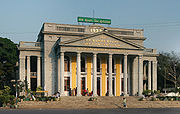 Bangalore Town Hall
Bangalore Town Hall 
Notice of No Original Research Noticeboard discussion
![]() There is currently a discussion at Misplaced Pages:No original research/Noticeboard regarding an issue with which you may have been involved. Thank you.
There is currently a discussion at Misplaced Pages:No original research/Noticeboard regarding an issue with which you may have been involved. Thank you.
October 2021
Buddha related FPs I
-
 Battered religious figures stand watch on a hill above a tattered valley. Nagasaki, Japan. September 24, 1945
Battered religious figures stand watch on a hill above a tattered valley. Nagasaki, Japan. September 24, 1945 
-
 17th century Painting on cloth of of Buddha Shakyamuni as Lord of the Munis with Bodhisatvas in background.
17th century Painting on cloth of of Buddha Shakyamuni as Lord of the Munis with Bodhisatvas in background. 
-
 The Gathering of Four Buddhas. 1562 CE, National Museum of Art, Korea.
The Gathering of Four Buddhas. 1562 CE, National Museum of Art, Korea. 
-
 Two women walk past the huge cavity where one of the ancient Buddhas of Bamiyan used to stand, June 17, 2012. The monumental statues were built in A.D. 507 and 554
Two women walk past the huge cavity where one of the ancient Buddhas of Bamiyan used to stand, June 17, 2012. The monumental statues were built in A.D. 507 and 554 
Buddha related FPs II
-
 Monk walks in the morning after the rain in front of the Temple of the Emerald Buddha (Wat Phra Kaew), part of the Grand Palace, Bangkok, Thailand.
Monk walks in the morning after the rain in front of the Temple of the Emerald Buddha (Wat Phra Kaew), part of the Grand Palace, Bangkok, Thailand. 
-
Buddha Amitabha in His Pure Land of Suvakti, Central Tibet. 18th century; Ground mineral pigment on cotton

-
 English: Shakyamuni Buddha with Avadana Legend Scenes. Tibet. Date 19th century
English: Shakyamuni Buddha with Avadana Legend Scenes. Tibet. Date 19th century 
-
 Chiang Mai, Thailand: Buddhist Manuscript Library and Museum
Chiang Mai, Thailand: Buddhist Manuscript Library and Museum 
Hi
Hi, I noticed your contributions to the India page and wanted to introduce myself. I saw a lot of your contributions are from your own collections, are you a historian? I ask as a fellow academic and philosopher. Johnnytest5 (talk) 12:09, 28 May 2022 (UTC)
- Good morning. Yes, I have added some maps, stamps, and coins, but the credit for collecting them does not belong to me. They were handed down to me. Thanks so much for your nice note. Fowler&fowler«Talk» 15:09, 28 May 2022 (UTC)
Round 2
You might remember this discussion concerning an apparent "consensus" — attributed to Sitush — to exclude certain details from lead all articles on castes etc. The issue is being re-discussed at the Notice-Board for India related topics. Thanks for your participation, TrangaBellam (talk) 09:24, 1 June 2022 (UTC)
One general info needed
Dear FF Sir, I had added this on an Ahir page: " Ahirs who were mainly classed as having lowly status in the social hierarchy took to Sanskritisation an attempt by low castes to rise up the social ladder, often by tracing their origins to mythical warrior characters or following the lifestyle of higher varna." but after your recent changes on Yadav page, I am bit confused as to whether I should modify the lines on Ahir page and add your reference there to make it ambiguous or leave it as such as other references are very explicit in their description about non-elite status ( indirectly shudra) for this group. Sir, I request for your small response to it below here for the next step. I will go accordingly to it. Thanks RS6784/Akalanka820 (talk) 05:27, 2 June 2022 (UTC)
- Berti, Daniela; Kanungo, Pralay; Jaoul, Nicolas (2011). Cultural Entrenchment of Hindutva Local Mediations and Forms of Convergence (1st ed.). Routledge. p. 246. ISBN 978-1-138-65995-7.
Marginalised groups, often considered as Shudras, like the Ahirs (Yadavs), Kurmis and the Gujars, began to redefine their emerging political and economic role in society by fighting on the same 'religious' grounds. In so doing, they refashioned their status as warriors and kings who had played a special role in history as guardians of Hinduism (Gooptu 2001 : 195; see also Pinch 1996 : 118–38). Gyanendra Pandey (1990: 66–108) describes how, since the end of the 19th century, such processes of Sanskritisation (adoption of 'higher' forms of Hinduism) among lower castes have joined up with Hindu nationalist movements, such as the cow protection movement, and how these interrelations have been central to the formation of a Hindu and a Muslim community in northern India.

